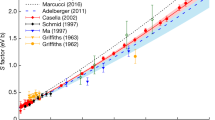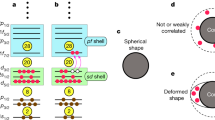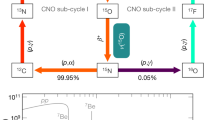Abstract
THE abnormally high helium content of several Palæozoic beryls discovered by Strutt1 has recently been verified by Paneth and Guenther.2 Atkinson and Houttermans have discussed3 the proton bombardment in the interior of the stars and the possible formation of Be8 which being probably unstable would yield two helium nuclei, and Lord Rayleigh4 suggests that the high helium content of beryls might conceivably be due to Be8 which has existed in geological times even if not known to exist at present. This implies, however, that Be8 existed at least in Palæozoic times, a relatively very late period since the star state and proton bombardment. The recent experiments of Cockcroft and Walton5 would indicate that Be8 can have only a very short life period. A possible source of excess helium might be found, however, in the following proposed mechanism: Be9 + α-particle = 3 He nuclei + neutron, and treating this in a similar manner to Chadwick's treatment,6 the maximum energy of the emission of the neutron is about 5.2 × 106electron volts as compared to 5.7 × 106 found in Chadwick's experiments and a maximum energy of about 8 × 106 electron volts given by the equation assuming C12 is the end product. If both mechanisms are possible we might then expect two groups of neutrons of different maximum energies. In the Palæozoic beryl, about 300 × 106 years old, radium was detected but no thorium. The α-particle of greatest kinetic energy is therefore from Ra C' which would give a maximum energy to the neutron of about 7.7 × 106 volts or about 10.5 × 106 if C12 is the end product.
This is a preview of subscription content, access via your institution
Access options
Subscribe to this journal
Receive 51 print issues and online access
$199.00 per year
only $3.90 per issue
Buy this article
- Purchase on Springer Link
- Instant access to full article PDF
Prices may be subject to local taxes which are calculated during checkout
Similar content being viewed by others
References
Proc. Roy. Soc., A, 80, 572; 1908. A, 84, 194; 1910.
Z. Phys. Chemie, B., 112, 170; 1928.
NATURE, 123, 567; 1929.
NATURE, 123, 607; 1929.
Proc. Roy. Soc., A, 136, 743; 1932
Proc. Roy. Soc., A, 136, 699; 1932
Proc. Roy. Soc., A, 136, 709; 1932
Author information
Authors and Affiliations
Rights and permissions
About this article
Cite this article
URRY, W. Helium Content of Beryllium. Nature 130, 777–778 (1932). https://doi.org/10.1038/130777b0
Issue Date:
DOI: https://doi.org/10.1038/130777b0
Comments
By submitting a comment you agree to abide by our Terms and Community Guidelines. If you find something abusive or that does not comply with our terms or guidelines please flag it as inappropriate.



